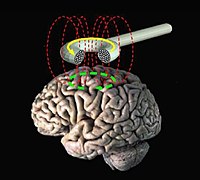
Photo from wikipedia
Researchers recently reported a naturalistic retrospective study of motor threshold (MT) data from 374 patients treated with TMS for depression from 2000 to 2019 [1]. MT was measured each day… Click to show full abstract
Researchers recently reported a naturalistic retrospective study of motor threshold (MT) data from 374 patients treated with TMS for depression from 2000 to 2019 [1]. MT was measured each day of treatment, “using the visual method”. It is reported that compared to the baselineMT, for each patient, each day, theMT varied (increasing or decreasing) on average more than 5%. It was also stated that “more extreme variations ( 25% above or below the first MT)” could occur. The researchers’ conclusion was that when MT is only determined once, at the commencement of treatment, there is danger of “underdosing” and “overdosing” with potential therapeutic and safety consequences. In consequence the authors suggest “daily or at least weekly MT determination”. The recommended stimulation intensity range is 110e120% MT [2]. However, in blinded studies, successful treatment has been achieved at 80% [3], 90% [4] and 100% [5] MT. Thus, if treatment is provided in the recommended stimulation intensity range, it is extremely unlikely that the variation in MT could be so great that the stimulation provided (according to the initial MT determination) could be too low to render clinical benefit. At the request of neurosurgeons who were planning to remove epileptic foci, we have attempted to induce seizure (to display foci) in conscious patients using standard therapeutic TMS devices. We have been unsuccessful, having to desist due to patient discomfort before any evidence of seizure activity whatsoever. There is no evidence to indicate that the individual's TMS MT and seizure threshold (should there be one for a particular individual) have a fixed relationship. It is probable they are independent, and the lowering of the MT does not mean there would be a lowering of any TMS seizure threshold. Thus, there is no evidence that variability leading to the lowering of the TMS MT increases the risk of TMS induced seizure. Members of the Clinical TMS Society participated in a survey to clarify the risk of TMS induced seizure [6]. The overall rate was 0.31 seizures per 10 000 treatments. For apparatus using generic figure8 coils the rates were lower (for example, the Neuronetics device the estimated rate was 0.03 seizures per 10 000 treatments). We accept that during a course of TMS for the treatment of depression, day to day variation in MT of at least 5% (and perhaps
Journal Title: Brain Stimulation
Year Published: 2021
Link to full text (if available)
Share on Social Media: Sign Up to like & get
recommendations!